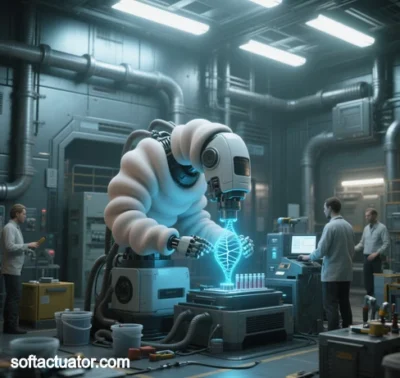
Integration of Soft Actuators and Biosynthetic Technologies: Prospects and Achievements
I. Core Principles of Technological Integration
The fusion of biosynthetic technologies with soft actuators combines synthetic biology, gene editing, flexible materials, and biomimetic mechanics to achieve:
- Bionic Function Enhancement: Mimicking the dynamic responsiveness of biological muscles and nervous systems to equip soft actuators with adaptability, self-healing, and environmental interactivity.
- Biocompatibility Breakthroughs: Using biodegradable or synthetic biomaterials to reduce rejection of traditional synthetic materials in biological systems.
- Intelligent Feedback Loops: Genetically engineered cells or microbes act as sensors, enabling real-time signal transmission and adaptive motion control in soft actuators.
II. Key Innovations and Case Studies
- Advances in Biosynthetic Materials
- Self-Healing and Biodegradable Materials:
Protein-engineered materials (e.g., recombinant elastin) enable rapid self-repair (e.g., a Penn State team’s synthetic protein material restores 90% mechanical strength in 10 minutes at room temperature) and controlled degradation (e.g., 3D-printed bio-gels from Austrian researchers degrade fully in days). These address fatigue failure and environmental pollution caused by traditional silicones/polymers. - Biohybrid Actuation Systems:
Gene-edited living cells (e.g., engineered E. coli or cardiomyocytes) embedded in flexible substrates enable chemical-to-mechanical energy conversion. Examples:
- Self-Healing and Biodegradable Materials:
- Biohybrid Grippers: Soft grippers with synthetic bacteria detect chemical signals (e.g., IPTG) and convert them into electrical commands via LED circuits for pneumatic actuation.
- Cardiomyocyte-Driven Robots: Millimeter-scale swimming robots powered by cardiomyocyte contractions respond to electric or light stimuli.
- Medical and Implantable Devices
- Targeted Drug Delivery:
pH-/temperature-responsive hydrogels (e.g., poly(N-isopropylacrylamide)) release chemotherapy drugs or insulin in tumor microenvironments. Trials show sustained normoglycemia in diabetic mice for five days. - Neural and Cardiovascular Interfaces:
- Targeted Drug Delivery:
- Shape-Morphing Neural Probes: 4D-printed electrodes self-fold via hydration to wrap nerve bundles, minimizing implantation damage.
- Cardiac Voltage Mapping Arrays: Soft multi-electrode arrays conform to left atrial anatomy via body heat, enabling high-precision electrical signal capture.
- Environmental Responsiveness and Energy Autonomy
- Chemically Driven Soft Robots:
Synthetic biology-designed “biofuel cells” power actuators. Examples:
- Chemically Driven Soft Robots:
- Gene-edited yeast generates electricity from organic matter to drive microrobots.
- Photosynthetic bacteria energize hydrogel actuators for light-controlled shape-shifting.
- Environmental Remediation:
Biodegradable soft robots deploy engineered microbes to detect and degrade pollutants. For example, polycaprolactone (PCL)-based detectors degrade post-mission, avoiding microplastic pollution.
- Environmental Remediation:
III. Technical Challenges and Breakthrough Strategies
- Material and Manufacturing Hurdles
- Bio-Synthetic Interface Compatibility: Develop extracellular matrix-mimicking coatings (e.g., recombinant laminin) to enhance cell-substrate adhesion.
- Scalable Production: Microfluidic 3D bioprinting achieves millimeter-scale resolution for cell-material co-deposition.
- Long-Term Stability: Encapsulation techniques (e.g., microencapsulated living cells) and self-sustaining energy systems (e.g., photosynthetic/chemical loops).
- Control and Intelligence Bottlenecks
- Signal Latency: Mismatch between slow biosensor responses (minutes) and electronic actuation (milliseconds).
→ Solution: Optogenetic regulation enables subsecond signal triggering via light pulses. - Multimodal Coordination: CRISPR-based genetic circuits create logic gates for “IF-THEN” conditional actions in biohybrid actuators.
- Signal Latency: Mismatch between slow biosensor responses (minutes) and electronic actuation (milliseconds).
- Ethical and Safety Concerns
- Biocontamination Risks: Environmental leakage of engineered microbes.
→ Solution: Integrate “suicide switches” (e.g., temperature-sensitive toxin genes). - Clinical Compliance: Immune rejection and long-term monitoring of living cell implants.
→ Progress: Use induced pluripotent stem cell (iPSC)-derived autologous cells to reduce rejection.
- Biocontamination Risks: Environmental leakage of engineered microbes.
IV. Future Prospects and Applications
- Medical Revolution
- Smart Surgical Robots: Soft catheters equipped with CRISPR-Cas9 detect diseased tissues and release gene-editing tools in real time.
- Dynamic Tissue Scaffolds: 4D-printed hydrogels morph in response to biomarkers (e.g., inflammatory cytokines) to aid nerve/vascular regeneration.
- Environmental and Industrial Applications
- Ecosystem Monitoring Networks: Biodegradable soft robot swarms monitor ocean acidification/pollutants and self-degrade.
- Flexible Factories: Microbe-actuator hybrid systems enable zero-waste chemical production.
- Human-Machine Interaction
- Biomimetic Exoskeletons: Artificial muscles powered by cardiomyocytes provide biomechanically aligned assistance.
- Emotive Feedback Devices: Synthetic skin with neural interfaces enables bidirectional tactile-emotional signal transmission.
V. Conclusion
The integration of biosynthetic technologies and soft actuators is redefining rigid mechanical systems, evolving toward adaptability, self-sustainment, and environmental harmony. Despite challenges in manufacturing complexity, control precision, and ethics, its potential in precision medicine, ecological restoration, and human-machine fusion is validated. Over the next decade, convergence of gene editing (e.g., CRISPR), synthetic biology, and flexible electronics may pioneer “living robots” —hybrid life-machine entities blending biological intelligence with mechanical prowess.
Data sourced from public references. For collaboration or domain inquiries, contact: chuanchuan810@gmail.com





